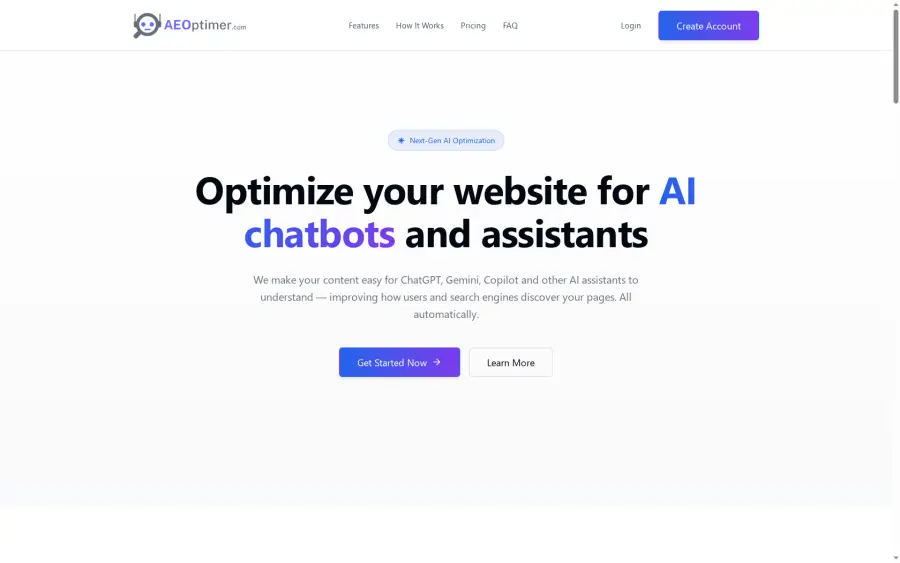How AI Finds Websites: Complete Guide for 2025

Over half of all web traffic is now driven by artificial intelligence, reshaping how websites are found and ranked. As AI systems analyze content in ways far more advanced than simple keyword matching, understanding these new discovery methods has become crucial for anyone wanting online visibility. With cutting-edge AI exploring context, structure, and meaning, learning how this process works can give your website a real advantage in the digital race.
Table of Contents
- Understanding How AI Discovers Websites
- Key Technologies Behind AI Website Discovery
- Role of Structured Data and Sitemaps
- AI-Friendly Content Optimization Strategies
- Common Challenges and How to Avoid Them
Key Takeaways
| Point | Details |
|---|---|
| AI Website Discovery | AI discovers websites through advanced web crawling, semantic analysis, and deep neural networks, leading to a comprehensive understanding of digital content. |
| Importance of Structured Data | Structured data and sitemaps are crucial for enhancing AI’s ability to interpret and index web content effectively. |
| Content Optimization Strategies | Content creators should focus on semantic clarity and structured information to ensure AI algorithms can assess the quality and relevance of their materials. |
| Challenges in AI Discovery | Common challenges include algorithmic bias and inconsistent metadata, necessitating a strategic approach to content development for optimal machine comprehension. |
Understanding How AI Discovers Websites
AI discovers websites through complex, multi-layered processes that combine advanced algorithmic techniques with sophisticated web crawling technologies. According to research from arXiv, AI algorithms now systematically analyze web content, link structures, and online data repositories to map and understand digital landscapes.
The core mechanisms of AI website discovery involve several critical components:
- Web Crawling: Automated bots that scan and index internet pages
- Semantic Analysis: Understanding context and meaning behind website content
- Link Graph Mapping: Tracking interconnections between different web resources
- Content Relevance Scoring: Evaluating information quality and significance
These AI systems do not simply collect website addresses. They perform deep, intelligent evaluations that go beyond traditional search engine indexing. By employing machine learning models, AI can now interpret nuanced website characteristics, understanding not just keywords but the underlying purpose and value of digital content.
An excellent example of this advanced discovery process comes from scientific research on webometrics. arXiv highlights how modern AI systems can detect intricate relationships between websites, analyzing not just individual pages but entire digital ecosystems. This means AI doesn’t just find websites - it comprehends their role, significance, and potential connections within broader information networks.
Website owners seeking optimal AI discoverability must recognize these sophisticated discovery mechanisms. It’s no longer about simple keyword optimization but creating rich, contextually meaningful content that AI algorithms can effectively parse and understand. Making Websites AI Discoverable: Step-by-Step Guide provides deeper insights into preparing your digital presence for these advanced AI discovery techniques.
Key Technologies Behind AI Website Discovery
AI website discovery relies on a sophisticated ecosystem of cutting-edge technologies that transform how digital content is identified, analyzed, and understood. Semantic Scholar exemplifies these advanced techniques, utilizing powerful natural language processing and machine learning algorithms to revolutionize digital content exploration.
The primary technologies driving AI website discovery include:
- Natural Language Processing (NLP): Enables machines to comprehend and interpret human language nuances
- Machine Learning Algorithms: Continuously improve discovery mechanisms through pattern recognition
- Deep Neural Networks: Analyze complex website structures and content relationships
- Semantic Analysis: Extract contextual meaning beyond simple keyword matching
These technologies work in concert to create a dynamic, intelligent web discovery system. Machine learning models can now recognize intricate content patterns, understanding not just the literal text but the underlying intent and significance of websites.
This represents a quantum leap from traditional search engine indexing, where simple keyword matching was the primary method of content discovery.
AI systems now employ contextual understanding that goes far beyond surface-level scanning. By integrating multiple technological approaches, these systems can map complex digital ecosystems, identifying connections and relationships that human researchers might overlook. Why AI Assistants Matter for Websites provides deeper insights into how these advanced technologies are transforming digital content interaction, demonstrating the profound impact of intelligent discovery mechanisms on how we navigate and understand online information.
Role of Structured Data and Sitemaps
Structured data and sitemaps are critical technologies that act as navigational blueprints for AI website discovery, transforming how intelligent systems understand and index online content. Otterly.ai highlights the pivotal role these tools play in optimizing search visibility and helping AI assistants comprehend website architectures more effectively.
The key components of structured data for AI discovery include:
- Schema Markup: Provides explicit context about webpage content
- JSON-LD Formats: Enables machine-readable content descriptions
- XML Sitemaps: Creates comprehensive website content roadmaps
- Metadata Annotations: Offers additional semantic information
Unlike traditional HTML, structured data speaks directly to AI algorithms, translating complex website information into clear, interpretable signals. These technologies allow AI systems to understand not just the text, but the underlying meaning, relationships, and significance of digital content. By providing precise, machine-readable information, websites can dramatically improve their chances of being accurately discovered and indexed by AI search technologies.

Sitemaps serve as the ultimate navigation guide for AI discovery mechanisms. They provide a comprehensive inventory of a website’s pages, helping AI crawlers efficiently map and understand digital content landscapes. This systematic approach ensures that even complex or deeply nested website structures can be fully explored and comprehended.
![]() Examples of Search Engine Optimization can offer additional insights into how these technical optimizations enhance overall digital visibility.
Examples of Search Engine Optimization can offer additional insights into how these technical optimizations enhance overall digital visibility.
AI-Friendly Content Optimization Strategies
As digital landscapes evolve, content optimization for AI discovery has become a critical strategic imperative. ICEF Monitor highlights a significant shift towards AI-driven search, emphasizing the urgent need for websites to adapt their content strategies to remain visible in intelligent search ecosystems.
Key optimization strategies for AI-friendly content include:
- Semantic Clarity: Use precise, contextually rich language
- Structured Information: Organize content with clear hierarchical formats
- Comprehensive Coverage: Provide in-depth, authoritative information
- Natural Language Alignment: Write in conversational, easily comprehensible styles
The core principle of AI content optimization revolves around creating transparent, meaningful content that AI algorithms can easily parse and understand. Unlike traditional SEO approaches, this strategy demands a more holistic view of content creation, focusing on depth, context, and genuine value. By anticipating how AI systems interpret and categorize information, content creators can develop materials that are not just keyword-rich, but genuinely informative and intelligently structured.
AI research tools underscore the importance of adaptable content strategies. Yomu AI emphasizes that successful content must be crafted with machine comprehension in mind, which means going beyond traditional writing techniques. How to Update Website Content for AI Visibility offers practical insights into transforming your digital content to meet these emerging AI discovery requirements.
Common Challenges and How to Avoid Them
Website owners face numerous complex challenges when optimizing for AI discovery, with data quality and algorithmic interpretation presenting significant hurdles. Stanford HAI highlights the critical importance of addressing data-related challenges to ensure effective AI interactions and visibility.
Common challenges in AI website discovery include:
- Algorithmic Bias: Unintentional skewing of content interpretation
- Inconsistent Metadata: Unclear or conflicting website information signals
- Content Complexity: Overly technical or poorly structured information
- Dynamic Content Management: Keeping websites consistently optimized
The most significant challenge lies in creating content that is simultaneously human-readable and machine-comprehensible. arXiv Research emphasizes the critical need for reliable and valid content strategies that can be effectively parsed by AI systems. This requires a delicate balance between natural language and structured, semantic information that AI algorithms can accurately interpret.
Mitigating these challenges demands a proactive and strategic approach to content creation. Website owners must develop a nuanced understanding of how AI systems process and categorize information, continuously adapting their content strategies to align with evolving AI discovery mechanisms. How to Update Website Content for AI Visibility offers practical guidance for navigating these complex optimization requirements.
Take Control of How AI Sees Your Website Today
The article highlights major challenges websites face in adapting to advanced AI discovery methods such as semantic analysis, structured data, and continuous content optimization. If you are worried about algorithmic bias, inconsistent metadata, or complex content that AI struggles to understand you are not alone. Many site owners want to ensure their pages remain visible and relevant as AI assistants like ChatGPT and Gemini reshape search experiences. This requires more than traditional SEO. It calls for expert automation that can add structured data and optimize your site without changing how it looks.

At aeoptimer.com, we specialize in automatically transforming your website’s content and technical foundations to match the demands of AI search. Our platform crawls, analyzes, and updates your pages monthly using proven techniques like automatic sitemap detection, semantic markup, and AI-friendly content enhancements. There is no complicated setup or coding needed on your part. Make your website smarter and easier for AI to find with confidence. Start now to stay ahead as AI continues to change how websites are discovered and ranked. Visit aeoptimer.com and learn more about how to update website content for AI visibility to take the first step toward effortless AI optimization.
Frequently Asked Questions
How do AI algorithms discover websites?
AI algorithms discover websites through web crawling, semantic analysis, link graph mapping, and content relevance scoring, allowing them to deeply evaluate and understand digital content.
What technologies support AI website discovery?
Key technologies include Natural Language Processing (NLP), Machine Learning algorithms, Deep Neural Networks, and Semantic Analysis, all of which enhance the understanding of website structures and interconnections.
How can website owners improve AI discoverability?
Website owners can improve AI discoverability by creating rich, contextually meaningful content, utilizing structured data, and implementing XML sitemaps that guide AI crawlers through their digital content.
What are some challenges in optimizing for AI website discovery?
Common challenges include algorithmic bias, inconsistent metadata, overly complex content, and the need for dynamic content management to keep up with evolving AI discovery mechanisms.
Recommended
- Making Websites AI Discoverable: Step-by-Step Guide | AEOptimer.com
- What Is AI Search? Complete Overview for 2025 | AEOptimer.com
- How to Audit Website for AI: Step-by-Step Visibility Guide | AEOptimer.com
- Why AI Assistants Matter for Websites: Complete Guide | AEOptimer.com
- Inteligencia Artificial: Todo Lo Que Debes Saber - Aithor
- IA Inteligencia Artificial: Guía Completa y Aplicaciones - Aithor





